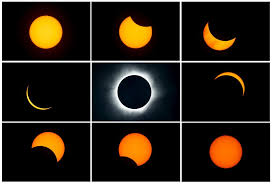Historical Solar Eclipse 2017 Following Adventure
 On August 21, 2017, all of North America will be treated to
an eclipse of the sun. Viewers around the world will be provided a wealth of
images captured before, during, and after the eclipse by 11 spacecraft, at
least three NASA aircraft, more than 50 high-altitude balloons, and the
astronauts aboard the International Space Station – each offering a unique
vantage point for the celestial event.
On August 21, 2017, all of North America will be treated to
an eclipse of the sun. Viewers around the world will be provided a wealth of
images captured before, during, and after the eclipse by 11 spacecraft, at
least three NASA aircraft, more than 50 high-altitude balloons, and the
astronauts aboard the International Space Station – each offering a unique
vantage point for the celestial event.
Over the course of 100 minutes, 14 states across the United
States will adventure experience more than two minutes of darkness in the middle of the
day. Additionally, a partial eclipse will be view able across all of North
America.

The eclipse will
provide a unique opportunity to study the sun, Earth, moon and their
interaction because of the eclipse’s long path over land coast to coast.
Scientists will be able to take ground-based and airborne observations over a
period of an hour and a half to complement the wealth of data and images
provided by space assets.

It is never safe to look directly at the sun's rays - even if
the sun is partly obscured. When watching a partial eclipse you must wear
eclipse glasses at all times if you want to face the sun, or use an alternate
indirect method. This also applies during a total eclipse up until the time
when the sun is completely and totally blocked. During the short time when the
moon completely obscures the sun - known as the period of totality - it is safe
to look directly at the star, but it's crucial that you know when to take off and
put back on your glasses.

During the 21st century, there will be 224 solar eclipses of
which 77 will be partial, 72 will be annular, 68 will be total and 7 will be
hybrids between total and annular eclipses. Of these, two annular and one total
eclipse will be non-central,
In the sense that the
very center (axis) of the moon's shadow will miss the earth (for more
information see gamma).

In the 21st century
the greatest number of eclipses in one year is four, in 2011, 2029, 2047, 2065,
2076, and 2094. The predictions given here are by Fred Espenak of NASA's
Goddard Space Flight Center.

So far, the longest duration in which the moon totally
covered the sun, known as totality, was during the solar eclipse of July 22,
2009. This total solar eclipse had a maximum duration of 6 minutes and 39
seconds. The longest possible duration of a total solar eclipse is 7 minutes
and 32 seconds. The longest annular solar eclipse of the 21st century took
place on January 15, 2010, with a duration of 11 minutes and 8 seconds. The
possible maximum duration is 12 minutes and 29 seconds. The eclipse of May 20,
2050, will be the second hybrid eclipse in the span of less than one year, the
first one being on November 25, 2049.

A solar eclipse (Annular) occurred on February 26, 2017; the
last solar eclipse (Total) occurred on August 21, 2017.
The list contains the date and time of the greatest eclipse
(in dynamical time, which in this case is the time when the axis of the Moon's
shadow cone passes closest to the center of Earth; this is in Universal Time).
The number of the saris series that the eclipse belongs to is given, followed
by the magnitude of the eclipse (the fraction of the Sun's diameter obscured by
the Moon) and the type of the eclipse (either total, annular, partial or
hybrid). For total and annular eclipses, the duration of the eclipse is given,
as well as the location of the greatest eclipse (the point of maximum eclipse)
and the path width of the total or annular eclipse. The geographical areas from
which the eclipse can be seen are listed.
Historicalhttps://goo.gl/zw1BEr



Comments
Post a Comment